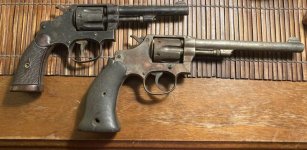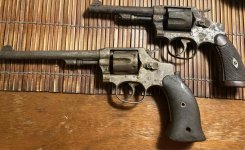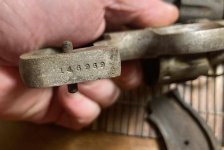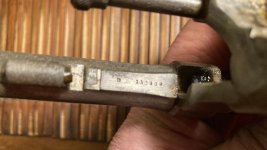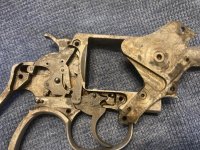I am not not a gun guy. I own an old .303 Lee-Enfied and Remington model 32 16 ga, which I used to hunt with as a teenager. These are my first pistols.
First one is a .32 Long with a 6" barrel. On the butt it has 146969. Under the barrel in front of the cylinder it has B 146969. This was found in a truck I inherited and has surface rusting. The mechanism works but the big spring in the grip is shattered in three pieces. The trigger comes back but won't fall unless I push it and it is not under any pressure then, just loose falls.
Second one I inherited from my uncle who got it form my grandfather who carried it as a sheriff deputy in about 1938-41. It is a .32 long with a 4" barrel. In front of the grip, facing trigger guard it has 369145. Inside the place where the cylinder hinges on the frame itself it has 14259. This one will not advance the cylinder when cocked. And you have to hold the cylinder release switch back (it stays forward all the time I think) in oder to cock the hammer. But the hammer fires when you pull the trigger.
Both of these were subjected to moisture and time and I have soaked them in penetrating oil and cleaned as much rust form them as i can. I washed them in hot soapy water a couple times too. Neither one will be much to look at, as there is pitting on the surfaces, but if repairable I'd like to try to at least keep the one my granddad carried and make it usable.
Any help identifying, suggesting repairs or other advice is much appreciated.
First one is a .32 Long with a 6" barrel. On the butt it has 146969. Under the barrel in front of the cylinder it has B 146969. This was found in a truck I inherited and has surface rusting. The mechanism works but the big spring in the grip is shattered in three pieces. The trigger comes back but won't fall unless I push it and it is not under any pressure then, just loose falls.
Second one I inherited from my uncle who got it form my grandfather who carried it as a sheriff deputy in about 1938-41. It is a .32 long with a 4" barrel. In front of the grip, facing trigger guard it has 369145. Inside the place where the cylinder hinges on the frame itself it has 14259. This one will not advance the cylinder when cocked. And you have to hold the cylinder release switch back (it stays forward all the time I think) in oder to cock the hammer. But the hammer fires when you pull the trigger.
Both of these were subjected to moisture and time and I have soaked them in penetrating oil and cleaned as much rust form them as i can. I washed them in hot soapy water a couple times too. Neither one will be much to look at, as there is pitting on the surfaces, but if repairable I'd like to try to at least keep the one my granddad carried and make it usable.
Any help identifying, suggesting repairs or other advice is much appreciated.

